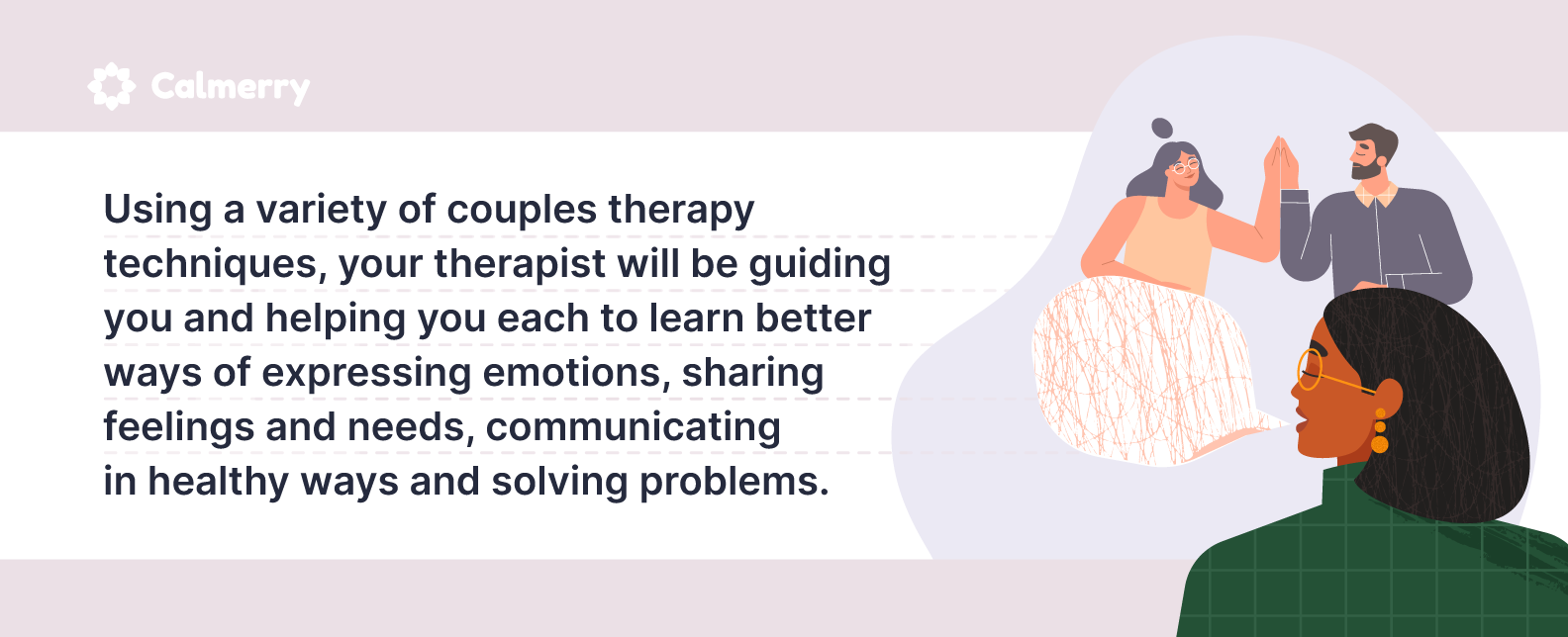Just What Do Couples Do in Couples Therapy?

In this article
You’ve found your therapist and made your appointment for couples therapy. You’ve even done some research on what to expect in a counseling session. You’ve probably read that you’ll be learning new skills and you might even have homework. But still, you may find yourself wondering, “What does that really mean? Just what do couples do in couples therapy?”
If the idea of just “what” you’ll be doing has you second-guessing your decision, you’re not alone. It’s a concern lots of couples have when they begin couples therapy, especially if it’s your first experience with therapy. Before you’re tempted to cancel that appointment, let’s pull the curtain back and take a closer look at some of the techniques and strategies your therapist may use to help you and your partner.
Couples therapy techniques and exercises
The most important thing to know before you go is that therapy is not a place to shame and blame either of you. Your therapist will create a safe space to talk about problems and help you work as a couple to find solutions. Your therapist is the guide. You and your partner have to do the work.
Therapy is an active process. Using a variety of couples therapy techniques, your therapist will be guiding you and helping you each to learn better ways of expressing emotions, sharing feelings and needs, communicating in healthy ways and solving problems, all in an effort to improve your level of emotional intimacy and connection.

Here is a sample of some of the couples therapy exercises and techniques you may encounter. Some of these may be done in session, while others may be part of your therapy homework.
Alignment
Alignment is a technique that allows you as a couple to come together in preparation for the work you’re going to do. Take some time to remember the positive times in your relationship and the strength you’ve found in each other as you’ve overcome past struggles. Reminiscing is a powerful way to help you to remember a time when you were happy and the relationship held so much possibility for you both.
There are lots of ways to do this: questions, “remember when” stories, and recalling fun times can all help you remember your “why” as a couple. Go back to the beginning, to a happy time in your relationship. Remember when you met, the things you value in each other.
Taking time to reconnect in this way helps to bring you together as you begin therapy. Your therapist may guide you through this alignment or may have you do this as part of homework.
Ice breakers
This one might sound more like a corporate meeting opener than a couples session exercise. In fact, coming to a therapy session is kind of like coming to a meeting and can carry a lot of the same feelings of anxiety.
Icebreakers are fun little activities designed to bring the anxiety and intensity of the situation down while encouraging conversation. There’s not any hidden agenda or “ulterior motive” here. These are most often used just to lighten the moment and help everyone to relax.
Also, icebreakers can be fun little games or asking questions like, “Tell me something funny that happened to you recently,” or “What was your favorite thing to do as a kid?”

Reflective listening
Reflective listening is a communication technique designed to improve listening and understanding. We often listen only to respond rather than listen to understand what someone is trying to say, which is the trigger for many a needless arguments.
The goal of this technique is to help the “listener” understand what the speaker is trying to say by listening and then repeating it back to the speaker to confirm that it was understood correctly. This is the essence of active listening.
On the other side of this communication is the speaker. The speaker has to be able to communicate feelings and needs clearly. A technique known as “I statements” is a positive way for the speaker to clearly express feelings and needs without being confrontational or accusatory. When someone hears “I feel…” rather than “you didn’t…”, it increases the chances of a more productive conversation.
Learning to listen and respond is a key element in communication for couples and one that you will likely spend a lot of time on.

The miracle question
If you woke up tomorrow and your problems were gone, what would that look like for you? How would you know?
This is an example of a technique called the Miracle Question. It is a technique that was first developed by Steve De Shazer and Insoo Kim Berg as part of solution-focused therapy. The idea is to have someone identify what their ideal solution or goal is.
The Miracle Question is also sometimes used in couples therapy. Each person identifies their own hope or goals for the relationship. Doing this allows each partner to express their own hopes and dreams while hearing their partner’s vision.
Couples journaling or therapeutic writing
Writing is a tool that is used in several approaches to therapy and is a powerful method for exploring feelings and gaining insight. Couples journaling or other types of expressive writing have been shown to help couples increase their understanding and insight into each other’s experiences. Your therapist may give you specific writing prompts or simply ask each of you to journal on a regular basis.
Talking about feelings
“Good” is not a feeling. Talking about feelings sounds easy, but it is actually one of the hardest things to do. Sometimes, you aren’t sure how you feel. Maybe you keep your feelings buried or learned that expressing feelings wasn’t safe. Whatever the reason, avoiding feelings can wreak havoc on a relationship.
If talking about feelings is hard for you, it’s ok. Therapy can help by giving you a safe place to learn how to get in touch with those deeper feelings. Your therapist may give you some exercises to help. One of the common techniques used is the I-statement.
I-statements
I-statements are a particular way of expressing your feelings in a positive way about how a situation affected you. I-statements express what you want the other person to know about what happened without accusing or blaming them. Some examples of I-statements include:
“I feel…”
“I need…”
When communication breaks down, we tend to use language that blames or accuses such as “you didn’t…” or “you never…”. These statements convey anger and place the other person on the defensive. At that point, no one is listening. When you begin with ‘I’, rather than ‘You’, you are giving the other person information to understand your feelings and needs while lessening the chance of them feeling attacked. It’s a subtle shift in phrasing but creates a powerful shift that can diffuse or avoid conflicts.

Eye contact exercises
These exercises are sometimes referred to as “gazing” or “soul gazing” and have been found to enhance intimacy and connection. Making eye contact is one of the most powerful non-verbal ways of communicating. It is also one of the most uncomfortable for people. There are many variations of this activity, but the goal is to help couples to connect and understand how each other is feeling.
Essentially, the couple sits across from each other and makes eye contact while sitting, relaxed and still, without speaking. As you gaze into each other’s eyes, you allow your feelings to come to the surface of your awareness. These gazing sessions generally last a few minutes. At the end of that time, you can share what you felt and any thoughts or sensations that came up.
Practicing gratitude
This one may sound odd for a couples therapy strategy. The fact is, gratitude is a powerful practice that has proven benefits for the health of couples relationships. Expressing gratitude to your loved one triggers the release of oxytocin, also known as the “love hormone”, and promotes bonding and closeness.

And practicing gratitude is something you can practice on your own, even before you go to couples therapy! A daily expression of gratitude for your partner can help you strengthen your bond as a couple.
Learn the language of love
You’ve probably heard of The Five Love Languages, popularized by the book of the same name. In essence, the idea behind love languages is that we each have a concept of what signals “love” to us. For some, it’s receiving gifts or your partner doing helpful things. For others, it’s spoken words of love and affection, physical touch, or making time for each other.
One of the ways to strengthen your relationship and communicate “love” to your partner is to do things that “speak” to their heart. But how do you know what that is? If you’re not sure, it’s ok to ask. Talk about it. Your therapist can help you initiate that conversation in a way that feels comfortable.
Have a date
When was the last time you had a real date with your partner? If you can’t remember, it’s probably been too long. Making time for each other that doesn’t involve kids, work, household issues, the dog, etc., is one of the first things therapists will often recommend. Why? Because life gets in the way, and couples get disconnected, not even meaning to.
It is not uncommon for therapists to recommend that you schedule some couples time to reconnect and enjoy some time away from the everyday stressors. The goal is to reestablish the connection and importance of couples time in a healthy relationship. Reclaiming some couples time can help you to reconnect and start growing together again.
What works
So, with all these options, you’re probably wondering, “What is the most effective form of couples therapy?” Well, that depends. It’s more than just an approach, technique, or exercise.

Although no approach or technique is 100% effective all the time, couples therapy can be highly effective for couples with all kinds of issues. Along with the connection that you make with your therapist, change in you, your partner, and your relationship requires action.
In other words, you have to engage in the process and be willing to do the work. When you and your partner embrace the process, you increase the chances that you will have a successful outcome.
Conclusion
If you and your partner are struggling or just wondering how couples therapy can help your relationship, reach out to an experienced couples therapist. Getting help is easier than ever before. Online couples therapy is convenient, affordable, and shown to be as effective as in-person counseling. Help is out there when you’re ready.
Try Calmerry therapy
online therapy
live video session



